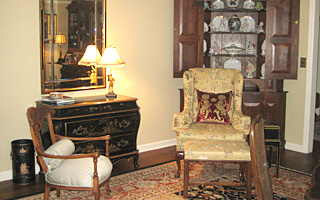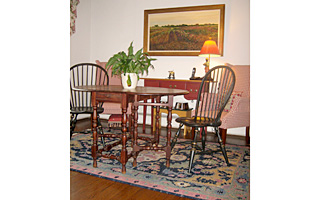 Antique furniture can work in any style of home, with any style of decor. Whether you live in a contemporary ranch with an open floor-plan, a center-entrance colonial, or a small studio apartment, antiques can co-mingle with your existing furniture, like moveis vintage, and design. Flip through some issues of “Elle Decor” or “House Beautiful;” the most beautiful rooms often have rare antiques next to very contemporary or common everyday pieces. It’s the mix of something old with something new that transforms a ho-hum room you might see in a catalog into a sophisticated, personalized space. One well-crafted, quality antique can elevate an entire room.
Antique furniture can work in any style of home, with any style of decor. Whether you live in a contemporary ranch with an open floor-plan, a center-entrance colonial, or a small studio apartment, antiques can co-mingle with your existing furniture, like moveis vintage, and design. Flip through some issues of “Elle Decor” or “House Beautiful;” the most beautiful rooms often have rare antiques next to very contemporary or common everyday pieces. It’s the mix of something old with something new that transforms a ho-hum room you might see in a catalog into a sophisticated, personalized space. One well-crafted, quality antique can elevate an entire room.
While studying Interior Design at Parsons, I was spoiled with an Antiques Class that met at the Met each week. I spent every Tuesday wandering the halls of the American Wing, admiring incredibly crafted pieces of furniture. My teacher owned a gallery with her husband, and her career buying and selling antiques spanned nearly five decades. Her vast knowledge about each period of furniture was incredibly intimidating. The first thing she did when determining a chair’s make was to turn it upside down and inspect its construction. (Obviously, she demonstrated this practice in an antiques showroom, not at the Met.) She could date a dining chair from a simple flip! Studying antiques and becoming an expert can take a lifetime, so short of hiring a professional to guide you through the process, it’s best to just focus on buying a piece you love and that you can afford. I advise clients to treat shopping for antiques much like buying artwork; don’t expect a return on your investment. Instead, cherish and enjoy a piece while you have it and then pass it on to the next generation of admirers.
Once you’ve acquired a beloved antique, the question of how to care for it inevitably arises. The most critical thing to remember in caring for an old piece, is that you want to maintain it, rather than change or improve it. The worn, aged finish on a piece is referred to as it’s “patina,” and that patina is what gives a piece its unique beauty and value. Don’t ruin it by trying to “perfect” the piece! If you believe your piece to be of great value, take it to an expert before beginning any cleaning or polishing routines. In some cases, a slightly damaged piece in its original condition may be considered destroyed once you begin applying modern waxes and polishes to it.
 Some furniture experts warn against using furniture polishes, while others decry the use of paste waxes. Polishes often will leave an oily residue on your furniture which can attract dust, retain fingerprints, and, some argue, eventually destroy a finish. Alternatively, some experts worry that a wax paste can harden and build up over years of application, effectively hiding the original finish. My mother and mother-in-law, both owners and caretakers of many beautiful antiques, take opposing views on this issue, so I am going to refrain from taking a stance on this matter in the interest of self-preservation. I will say that a fairly common recommendation from professional antiques dealers is to apply a thin coat of furniture paste wax, like SC Johnson Paste Wax, every few months. Using a soft, lint-free cloth, apply small amounts, rubbing the wax gently in the direction of the wood grain. Then buff away any excess. In between waxing, simply dust with a soft, slightly damp cloth. Whether you choose to polish or wax, never use a silicone-based product, as the silicone can penetrate the hardest of lacquer finishes and destroy any future attempts at refinishing the piece. Also refrain from ever spraying an aerosol polish directly onto your furniture; it can permanently damage the finish.
Some furniture experts warn against using furniture polishes, while others decry the use of paste waxes. Polishes often will leave an oily residue on your furniture which can attract dust, retain fingerprints, and, some argue, eventually destroy a finish. Alternatively, some experts worry that a wax paste can harden and build up over years of application, effectively hiding the original finish. My mother and mother-in-law, both owners and caretakers of many beautiful antiques, take opposing views on this issue, so I am going to refrain from taking a stance on this matter in the interest of self-preservation. I will say that a fairly common recommendation from professional antiques dealers is to apply a thin coat of furniture paste wax, like SC Johnson Paste Wax, every few months. Using a soft, lint-free cloth, apply small amounts, rubbing the wax gently in the direction of the wood grain. Then buff away any excess. In between waxing, simply dust with a soft, slightly damp cloth. Whether you choose to polish or wax, never use a silicone-based product, as the silicone can penetrate the hardest of lacquer finishes and destroy any future attempts at refinishing the piece. Also refrain from ever spraying an aerosol polish directly onto your furniture; it can permanently damage the finish.
While the great wax vs. polish debate wages on, there are a few steadfast rules for caring for your antiques. Avoid placing a piece in direct sunlight, as UV rays can bleach out the wood. Try to rotate the accessories you place on a table or sideboard so that they are not always sitting in the same spots. Extreme heat or cold can cause wood to expand and contract, which results in loose joints, swollen drawers, and cracked veneers, so don’t place an antique next to a heat or air conditioning vent. Most importantly, enjoy the piece while it’s in your home!
[blockquote class=blue]Kitty Burruss is an Interior Designer in Briarcliff Manor, NY. She was lucky enough to inherit a storage unit’s worth of heirloom furniture from her Grandmother and is currently not following any of the “rules” of caring for antiques.
Barbara Sternau Interior Design Box 404, Waccabuc, NY bsternau@optonline.net 914-631-1875 www.barbarasternau.com[/blockquote]






